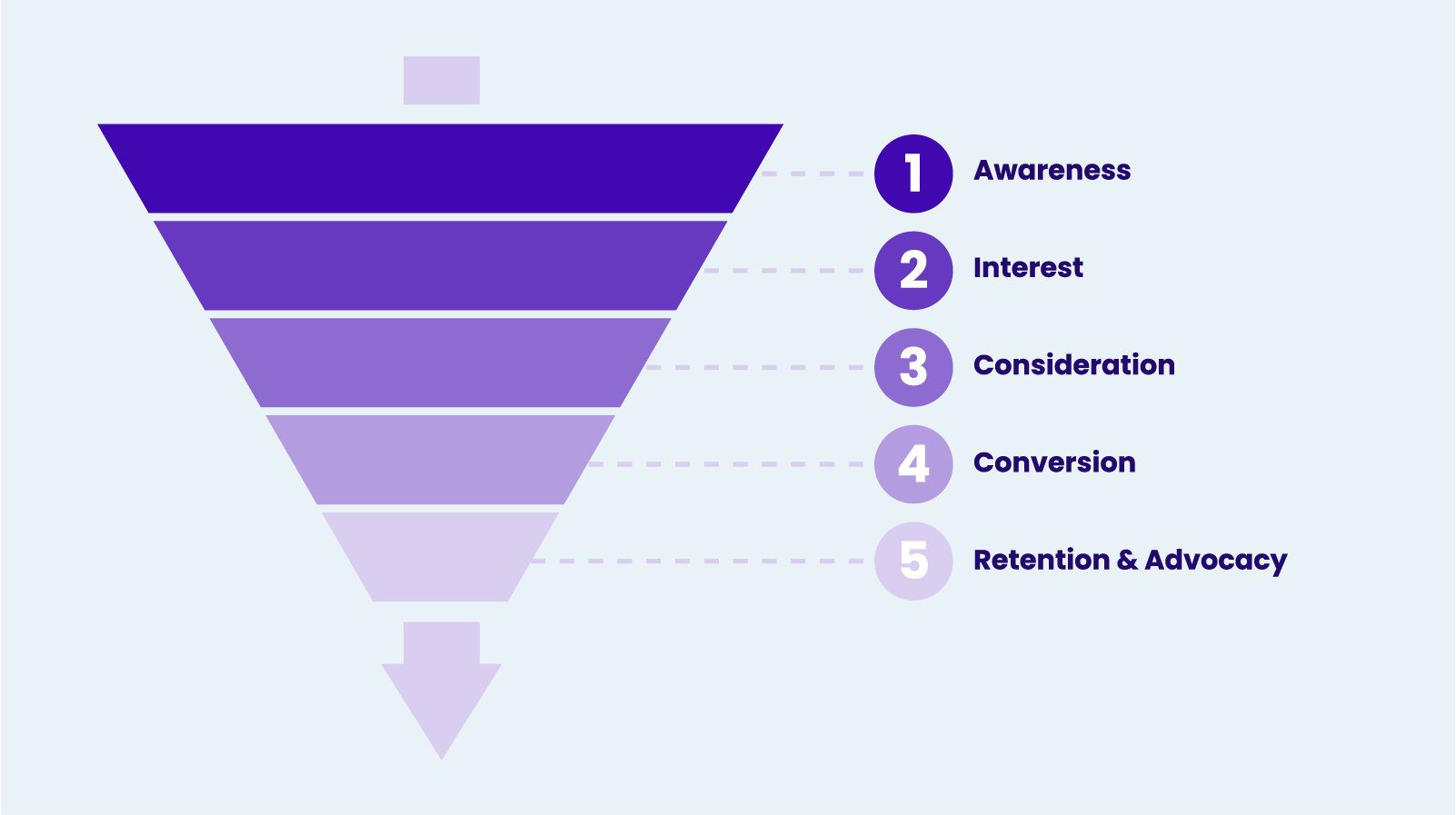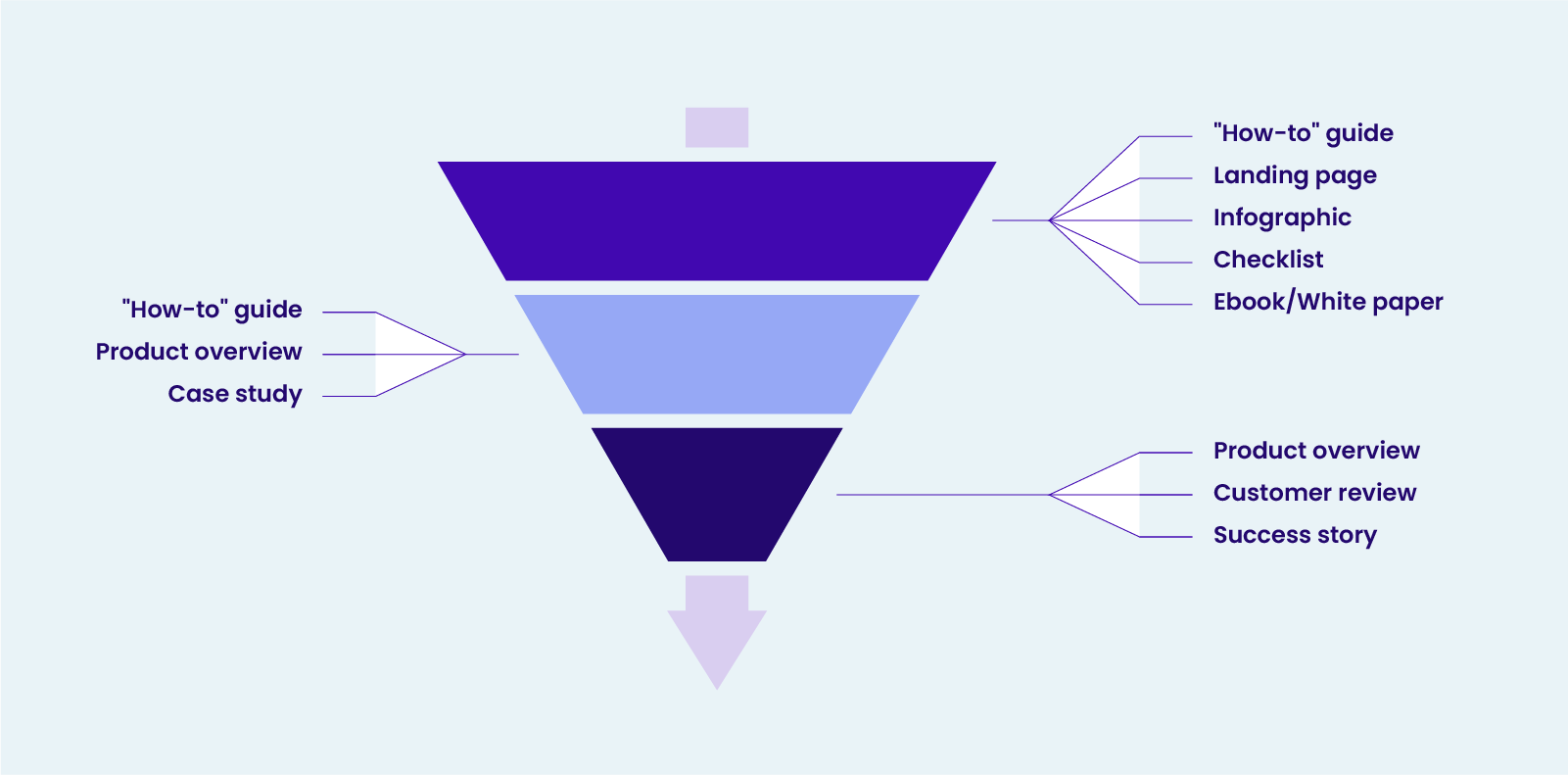The concept of a marketing funnel is one of the core differentiators between B2B marketing and B2C marketing.
This audience-centered model creates a tangible and visual depiction of the long and complex nature of B2B purchase cycles, while also providing a framework for marketing teams to build their strategies around.
What is the B2B marketing funnel?
The B2B marketing funnel is a representation of the progressive stages that businesses and their decision makers go through when making a purchase. It is described as a funnel to portray the expected narrowing of an audience from the top point (broad awareness) to the bottom (converted customers).
Traditionally, the B2B marketing funnel has been divided into five categories.

Stages of the B2B marketing funnel
- Awareness: A company becomes aware of a problem, pain point, or opportunity that it needs to act on.
- Interest: The company begins to explore vendors and solutions capable of helping solve their challenges.
- Consideration: Buyers and decision makers within the company reach the point of actively evaluating and comparing potential solutions.
- Conversion: The company chooses your solution and becomes a customer.
- Retention & Advocacy: The post-purchase relationship continues with the goal of retaining, upselling, or building customer advocacy.
Marketers often use the marketing funnel as a way to categorize and position their content. For example, top-of-funnel (TOFU) content might be focused on building brand awareness and expanding visibility with your target audience.
Bottom-of-funnel content (BOFU) is usually more oriented toward warm prospects who are already familiar and more likely to take action.
B2B marketing funnel vs. B2B sales funnel
Although they are often used interchangeably, you might sometimes hear “marketing funnel” and “sales funnel” referenced in different contexts. Some companies distinguish the two models based on their specific functions.
A B2B sales funnel might look more like this:
- Prospecting
- Qualification
- Proposal
- Notification
- Closing
The two variations are fundamentally similar in that they narrow down a broad field of potential customers into a more qualified set and eventually convert some of this set into won customers.
“79% of marketing leads never convert into sales due to a lack of lead nurturing.” (WifiTalents)
Why the top of the funnel matters
Historically, B2B marketers have had an understandable tendency to focus overwhelmingly on the lower part of the funnel. They are under pressure to drive and prove results, and the bottom of the funnel is where marketers can demonstrate their most direct revenue impact.
However, it’s critical for B2B companies to recognize that the vast majority of their potential buyers, at any given time, are not actively in the market for their solution. Marketing only to the small fraction of people who are ready to buy means missing a huge opportunity to develop brand recognition and salience with those who will be ready to buy in the future.
An effective upper-funnel strategy is essential for maximizing conversions within that segment of active buyers. Someone who knows, trusts and likes your brand is more likely to remember it or consider it when a need arises.
Reaching buying committees early is vital: A study by McKinsey found brands that made it into the initial consideration set were more than twice as likely to win business compared to brands considered later in the decision journey.
Read more on our blog: Top SEO Strategies for Lead Generation
Shortcomings of the B2B marketing funnel
The funnel concept is valuable as a shorthand tool for explaining the B2B customer journey and how marketing interacts with it at a high level. However, certain limitations should be considered, such as:
- Linearity: The marketing funnel can make a B2B purchase journey seem far more straightforward than it usually is.
- Oversimplification: B2B buying cycles and committees are too complex to be captured in such a basic paradigm.
- Neglects or minimizes post-purchase stages: Retention and the growth of existing accounts are central to many B2B business models (e.g. SaaS).
- Lack of adaptability: Using one singular consistent model to encompass all customer journeys doesn’t work in the evolving digital world of B2B commerce.
As Anouschka Elliott of Goldman Sachs Asset Management shared with Marketing Week: “The funnel is very, very useful to explain to non-marketers what we do… But we’re missing advocacy, we’re missing the loyalty, we’re missing that continued relationship we need to be building, and all of the complexity of the actual journey.”
Despite these shortcomings, the B2B marketing funnel is certainly helpful for orchestrating your marketing strategy at a high level. Here’s a framework.
How to build a B2B marketing funnel
Building a customized B2B marketing funnel tailored to your specific brand, solutions, and audience is a helpful exercise for guiding your keyword strategy, content creation, and measurement approach.
#1. Conduct in-depth audience research
Lay groundwork for your marketing funnel by understanding it from the perspective of your customers and prospects.
#2. Develop an intent-based customer journey map
Intent-driven keyword research will help you understand how your audience searches for information and engages with content at each stage of the marketing funnel, from their first interaction to the completed purchase.
#3. Create strategic content for various funnel stages
Organize your content strategy around the marketing funnel, as informed by your customer journey map, to ensure you are meeting user intent at every stage. CTAs should be dictated by the logical action that helps prospects progress forward.
#4. Integrate organic and paid marketing activities
A balanced and coordinated combination of organic and paid marketing helps a full-funnel strategy work. Use broad organic acquisition to fill the upper funnel and invest in paid media to generate demand, nurture prospects, and convert customers.
#5. Measure and optimize
As with any aspect of B2B marketing, rigorous and relentless measurement will hold the key to success. Track the effectiveness of your content and ads relative to their specific funnel stages to keep optimizing for desired outcomes across the customer journey.
Which content works at different funnel stages?
The answer to this question will vary based on the brand, solutions and audience. However, a survey by Semrush (via Search Engine Journal) found that these content types are most effective at different marketing funnel stages. As you’d expect, educational content and resources are most popular at the top, while case studies and product information lead at the lower funnel.

Top of Funnel Content:
- “How-to” guide
- Landing page
- Infographic
- Checklist
- Ebook/White paper
Middle of Funnel Content:
- “How-to” guide
- Product overview
- Case study
Bottom of Funnel Content:
- Product overview
- Customer review
- Success story
70% of marketers say organic search is the most efficient channel in attracting traffic at the top of the funnel. (Search Engine Journal)
Measuring results across marketing funnel stages
Ensuring that your measurement strategy aligns to your marketing funnel is how you verify that you are optimizing for the right outcomes. For example, marketers who measure solely by lower-funnel metrics are at risk of sacrificing future growth by overlooking key upper-funnel metrics.
These are some common marketing metrics used at each stage of the B2B funnel:
Awareness
- Website traffic
- Social media reach and engagement
- Brand mentions
- Share of voice
Interest
- Click-through rate
- Content conversion rate
- Leads generated
Consideration
- Content engagement
- Lead quality
- Opportunities generated
Conversion
- Lead/opportunity conversion rate
- Average deal size
- Sales cycle length
Retention & Advocacy
- Customer lifetime value
- Retention rate
- Referrals/upsells
Keep your B2B marketing funnel flowing
The support of seasoned experts who fully understand the B2B marketing funnel and its fundamentals is invaluable. Learn about TopRank Marketing’s strategy and planning services, and how we can help you build a sustainable growth machine.



